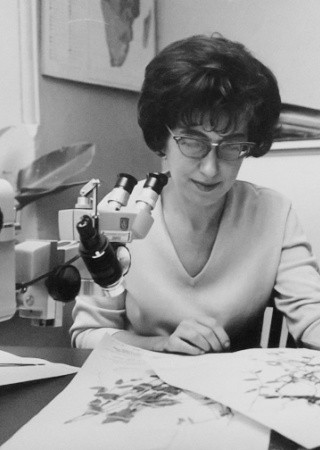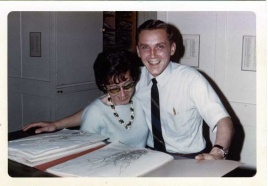Cleofé Calderón
- … Calderón was a polyglot? She was fluent in English, Spanish, and Portuguese.
- … the genus Calderonella is named after her?
- … the U.S. National Herbarium houses about 1,000 of her collected specimens?
- … due to her poor eyesight, her botany friends affectionately referred to her as “Mrs. Magoo”?
- … Calderón shares a birthday with Eduardo Caballero y Caballero, a parasitologist also featured in this exhibition?
- … Calderón named 18 new species of grass?
- 1929 – October 26 – Born in Buenos Aires, Argentina
- 1955 – First collects in Argentina
- 1956 – Graduates as professor of Natural Science from the University of Buenos Aires
- 1961 – Publishes her first article
- 1961 – Visits Washington, D.C. for the first time
- 1965 – Begins to work as a grant-funded research collaborator at the Smithsonian Institution
- 1976 – Along with her assistant, Talmon dos Santos, rediscovers Anomochloa in Bahia, Brazil
- 1985 – Retires from botany and begins working for a bibliographic service
- 2005 – Retires and returns to Buenos Aires to be with family
- 2007 – Dies in Buenos Aires
Cleofé Calderón, or Cleo as she was known to friends and colleagues, was an accomplished grass specialist who spent years studying bamboo. She pursued a PHd in agrostrology in her native Argentina, but when an opportunity to visit Washington DC in 1961 opened up, she took it. Much of Calderón's work was conducted in collaboration with her friend Tom Soderstrom of the U.S. National Herbarium in the National Museum of Natural History; this work would serve as a foundation for the modern understanding of grass evolution. Calderón collected extensively in Central and South America, and was noted as being a very thorough, accomplished collector, taking extensive field notes and creating high quality pressings. One of the biggest finds in Calderón’s collecting trips was the rediscovery of Anomochloa, a genus of grass that scientists had not seen living since the 19th century. Although her collections may be relatively small and her career just about twenty years long, her specimens still provide integral information on grass evolution and morphology to researchers. Calderón’s mark on the world of bamboo studies is indeed quite remarkable.


